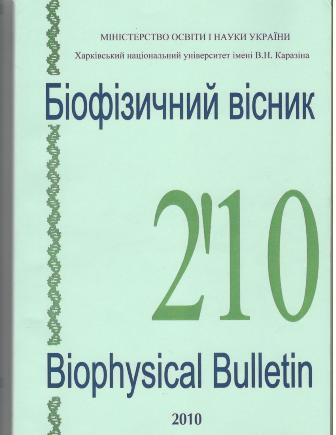Quantitative analysis of the benzanthrone aminoderivative binding to amyloid fibrils of lysozyme
Abstract
The accumulation of amyloid fibrils in different tissues is associated with a number of neurodegenerative
diseases. Despite a huge variety of amyloid-specific probes, all of them suffer from many drawbacks,
highlighting the necessity of searching for more preferable dyes. In the present work, the potential of new
fluorescent probe AM3 for selective detection of fibrillar protein aggregates, formed from lysozyme, has
been evaluated. To quantify the affinity of this dye for amyloid fibrils, the isotherms of dye binding to the
fibrillar lysozyme have been derived from fluorimetric titration. Parameters of the dye-protein
complexation: association constant, molar fluorescence, and binding stoichiometry, calculated from the
Langmuir adsorption model revealed that AM3 interacts strongly with protein insoluble aggregates. High
values of the binding parameters make AM3 an alternative to a widely-used amyloid-specific probe
Thioflavin T. We also investigated the effects of polarity and viscosity on AM3 fluorescence properties.
The binding of AM3 to the protein hydrophobic cavities has been followed by the redshift of the dye
emission spectra, which can be explained by H-bonding between proton-donating groups of the protein
and carbonyl moiety of the probe. A long-wavelength shift of emission maximum was observed also upon
increasing the excitation wavelength. This finding suggests that the reorientation time of solvent molecules is higher than the dye fluorescence lifetime. Fluorescence anisotropy studies revealed slow rotation
diffusion of the probe, bound to amyloid fibrils being indicative of high viscosity of AM3
microenvironment. The observed photophysical properties of the new aminobenzanthrone derivative
make AM3 a perspective probe for basic research and medical diagnostics.
Downloads
References
2. Stefani M., Protein misfolding and aggregation: new examples in medicine and biology of the dark side of the protein world // Biochim. Biophys. Acta 2004. V. 1739. P. 5-25.
3. Goda S., Takano K., Yamagata Y., Nagata R., Akutsu H., Maki S., Namba K., Yutani K. Amyloid protofilament formation of hen egg lysozyme in highly concentrated ethanol solution // Protein Sci. 2000. V. 9. P. 369-375.
4. Gorbenko G., Trusova V., Kirilova, E., Kirilov G., Kalnina I. New fluorescent probes for detection and characterization of amyloid fibrils // Chem. Phys. Lett. V. 495. P. 275 – 279.
5. Volkova K., Kovalska V., Balanda A., Vermeij R., Subramaniam V., Slominskii Y., Yarmolyuk S. Cyanine dye-protein interactions: Looking for fluorescent probes for amyloid structures // J. Biochem. Biophys. Meth. 2007. V. 70. P. 727-773.
6. Groening M. Binding mode of Thioflavin T and other molecular probes in the context of amyloid fibrils – current status // J. Chem. Biol. 2010. V. 3. P. 1-18.
7. LeVine H. Thioflavin T interaction with synthetic Alzheimer’s disease β-amyloid peptides: Detection of amyloid aggregation in solution // Protein Sci. 1993. V. 2. P. 404-410.
8. Khurana R., Coleman C., Ionescu-Zanetti C., Carter S., Krishna V., Grover R., Roy R., Singh S. Mechanism of Thioflavin T binding to amyloid fibrils // J. Struct. Biol. 2005. V. 151. P. 229-238.
9. Kutsenko O., Trusova V., Gorbenko G., Dobrovolskaya E., Striha O., Derkach R. Spectral behaviour of amyloid-specific dyes in protein-lipid systems. III. Congo Red interactions with native proteins // Біофізичний вісник. 2008. Т. 21. С. 50-55.
10. Lai B., Cao A., Lai L. Organic cosolvents and hen egg white lysozyme folding // Biochim. Biophys. Acta. 2000 V. 1543. P. 115-122.
11. Kirilova E., Kalnina I., Kirilov G., Meirovics I. Spectroscopic study of benzanthrone 3-n-derivatives as new hydrophobic fluorescent probes for biomolecules // J. Fluoresc. 2008. V. 18. P. 645-648.
12. Nilsson M. Techniques to study amyloid fibril formation in vitro // Methods. 2004. V. 34. P. 151-160.
13. Biancalana M., Makabe K., Koide A., Koide S. Molecular mechanism of Thioflavin T binding to the surface of β-rich peptide self-assemblies // J. Mol. Biol. 2009. V. 385. P. 1052-1063.
14. Lakowicz J. Principles of fluorescence spectroscopy, Springer: New York, 2006
15. Chattopadhyay A. Mukherjee S. Red edge excitation shift of a deeply embedded membrane probe: implications in water penetration in the bilayer // J. Phys. Chem. B 1999. V. 103. P. 8180-8185.
Authors who publish with this journal agree to the following terms:
- Authors retain copyright and grant the journal right of first publication with the work simultaneously licensed under a Creative Commons Attribution License that allows others to share the work with an acknowledgement of the work's authorship and initial publication in this journal.
- Authors are able to enter into separate, additional contractual arrangements for the non-exclusive distribution of the journal's published version of the work (e.g., post it to an institutional repository or publish it in a book), with an acknowledgement of its initial publication in this journal.
- Authors are permitted and encouraged to post their work online (e.g., in institutional repositories or on their website) prior to and during the submission process, as it can lead to productive exchanges, as well as earlier and greater citation of published work (See The Effect of Open Access).





